PHOTO HISTORY
1941-1955: My Mother knew that I had loved music from the time I was an infant. Radio and records taught me pop and classical music, even though neither of my parents or siblings were musical. Mother put me into piano lessons with a wonderfully eccentric beach recluse named Norma Lyons for several years. I wasn't that devoted to practice, but when a band teacher was hired at our elementary school in North Bend, Oregon, he gave us all pitch-matching and other tests. On the basis that I had an excellent ear, he asked me to play trombone. But I wanted the shiny Olds cornet in the music store. Mother bought it for me, and my career as a musician began. I was absolutely devoted to it and practiced daily. When we moved to the Portland suburbs, the band director at Raleigh Hills Elementary, who played tuba, picked me and five others to form a school dixieland band. We got to miss classes in order to travel with him to other schools and do performances. Mother took me to Amato's night club in Portland to hear Louis Armstrong's band in about 1953, and I was able to sit on the floor about ten feet away from the Great One. I was electrified. A year later when we visited relatives in Kentucky, Mother took me to the Newport Jazz Festival, then she loaned me money to buy a Benge trumpet. By eighth grade I was practicing 2-3 hours daily and winning all the local solo contests.
On my eighth grade graduation photo I wrote: "You only get out of your horn that which you put into it, as in life today." Pretty philosophical, huh? Here's that photo, and here's Mother at age 93.
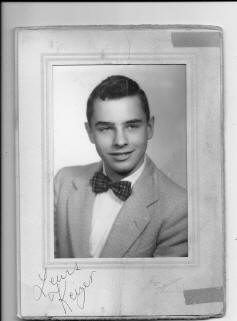
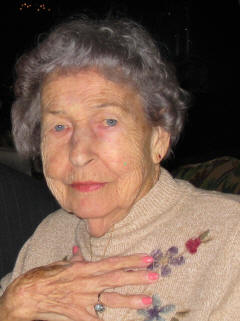
SOME HIGH POINTS OF MY JAZZ LIFE
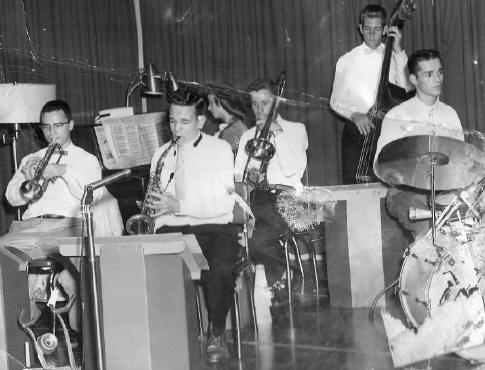 1955-1961:
At Beaverton High School I played
weekend high school dances that our teacher Al Robertson booked for the
Swingmasters, a seven-piece elite version of the bigger school dance band. We
had a key to the band room for weekends and picked up all the stands, lights,
and music. Then we drove to various high schools--some as far as as forty miles
away. Then we set up, played, and collected our money. Usually $12/person. We
learned to run a music business and deal with customers. I did this my
Sophomore, Junior, and Senior years plus teaching private lessons to make money.
Don't have a photo of the Swingmasters, but here is one of another high school
band I was hired to play in run by Stan George when I was about 16 years old and
able to drive. I also played in the Portland Junior Symphony under Jacob
Avshalomov, one of the top youth symphonies of the 1950's, sat Principal Trumpet
in All-Northwest Band comprised of best high school players from five states,
was hired as Co-Concertmaster and Principle Trumpet for the Portland Civic
Theater orchestra at age 17, and at 18 was playing Third Trumpet in the Portland
Symphony Orchestra. I worked as a professional jazz musician at ages 19-21 in
the Portland area, and during my college year at UCSC was able to sit in with
Shelly Manne, Vince Guaraldi, Zoot Sims, and Curtis Counce, among others. I
played after-hours clubs and lots of casuals. Probably the high-points of that
period were backing Anita O'Day for two weeks in a quartet at a night club in
Portland and playing with bass player Monk Montgomerey, a brilliant and
dedicated musician who was practicing upright bass many hours a day at that
time, before his famous brother the guitarist Wes Mongomerey had been killed.
1955-1961:
At Beaverton High School I played
weekend high school dances that our teacher Al Robertson booked for the
Swingmasters, a seven-piece elite version of the bigger school dance band. We
had a key to the band room for weekends and picked up all the stands, lights,
and music. Then we drove to various high schools--some as far as as forty miles
away. Then we set up, played, and collected our money. Usually $12/person. We
learned to run a music business and deal with customers. I did this my
Sophomore, Junior, and Senior years plus teaching private lessons to make money.
Don't have a photo of the Swingmasters, but here is one of another high school
band I was hired to play in run by Stan George when I was about 16 years old and
able to drive. I also played in the Portland Junior Symphony under Jacob
Avshalomov, one of the top youth symphonies of the 1950's, sat Principal Trumpet
in All-Northwest Band comprised of best high school players from five states,
was hired as Co-Concertmaster and Principle Trumpet for the Portland Civic
Theater orchestra at age 17, and at 18 was playing Third Trumpet in the Portland
Symphony Orchestra. I worked as a professional jazz musician at ages 19-21 in
the Portland area, and during my college year at UCSC was able to sit in with
Shelly Manne, Vince Guaraldi, Zoot Sims, and Curtis Counce, among others. I
played after-hours clubs and lots of casuals. Probably the high-points of that
period were backing Anita O'Day for two weeks in a quartet at a night club in
Portland and playing with bass player Monk Montgomerey, a brilliant and
dedicated musician who was practicing upright bass many hours a day at that
time, before his famous brother the guitarist Wes Mongomerey had been killed.


1961-1975: I continued to play through college and graduate schools, but I don't have photos. So the photo history resumes when I was teaching Classics and Religious Studies at the University of California, Santa Cruz.
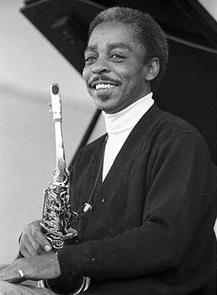 One
summer afternoon a student came into my office and said excitedly, "Dr. Keizer!
There's a guy playing sax with another guy on bass out in the woods, and I think
they may be pretty good!" I followed him into the redwoods, where I found the
great jazz musician Sonny Chris and his bass player Buddy Woodson. Sonny had
lived and performed in France for decades, where black artists were respected.
Now he had returned to his home in Los Angeles--a place called Watts. It was on
fire and wild with race riots. Sonny tried for a long to to get gigs, but there
were none. The night clubs were supporting acid rock--not jazz any more. So he
and Buddy decided to get trained as alcoholism counselors. They had come to the
UCSC summer session to earn their credentials. I said, "Let's do a concert." As
it happened, the Provost of College Five where I worked was a jazz fan. He
requisitioned a chunk for money, I hired a top-level jazz drummer and pianist
from the Bay Area, and we put on a wonderful quintet concert in the Dining Hall
that weekend with my trumpet and his alto sax. The night before I met with Sonny
in my apartment to rehearse and decide what we would play. He showed me the
meditation techniques and special diets he used after he quit drugs many years
before. He sat cross-legged on the floor to play. He was a great and under-rated
musician. Several years later in Los Angeles he developed incurable stomach
cancer and committed suicide with one shot to the head.
One
summer afternoon a student came into my office and said excitedly, "Dr. Keizer!
There's a guy playing sax with another guy on bass out in the woods, and I think
they may be pretty good!" I followed him into the redwoods, where I found the
great jazz musician Sonny Chris and his bass player Buddy Woodson. Sonny had
lived and performed in France for decades, where black artists were respected.
Now he had returned to his home in Los Angeles--a place called Watts. It was on
fire and wild with race riots. Sonny tried for a long to to get gigs, but there
were none. The night clubs were supporting acid rock--not jazz any more. So he
and Buddy decided to get trained as alcoholism counselors. They had come to the
UCSC summer session to earn their credentials. I said, "Let's do a concert." As
it happened, the Provost of College Five where I worked was a jazz fan. He
requisitioned a chunk for money, I hired a top-level jazz drummer and pianist
from the Bay Area, and we put on a wonderful quintet concert in the Dining Hall
that weekend with my trumpet and his alto sax. The night before I met with Sonny
in my apartment to rehearse and decide what we would play. He showed me the
meditation techniques and special diets he used after he quit drugs many years
before. He sat cross-legged on the floor to play. He was a great and under-rated
musician. Several years later in Los Angeles he developed incurable stomach
cancer and committed suicide with one shot to the head.
In the early 1970's jazz wasn't supported in clubs any more--it was all acid rock and folk music. I was getting stale playing Miles Davis bebop, so I decided to bust out of my cliches, go back to the roots, and learn the old dixieland jazz traditions of the '20's and '30's. My father-in-law Bill Popper had a huge collection of old vinyl he had collected in the 1930's in Berkeley that I transcribed to cassette tapes. Then I was asked to play with the Plum Forest Jazz Band in Santa Cruz. Bill Popper knew Lu Watters, who had revived and preserved the old jazz in the '40's in San Francisco and was now retired and working as a cook in Cotati, California. We sent our clarinet player Bob Fishback up to Lu, who gave us a copy of his entire repertoire. This was years before he made it available to the newly-forming trad jazz clubs. We rehearsed our trad repertoire every Thursday night and got some great gigs playing for Steve Allen and other celebrities. I learned the whole repertoire. In the band was Bill Newman, President of our local Musicians Union and retired as the NBC national studio guitarist. We also had several other top players. That was the beginning of my dixieland jazz career.
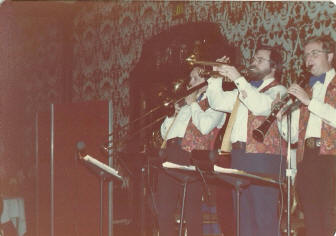
1975-1987:
A newspaper article about my jazz and classical sides:
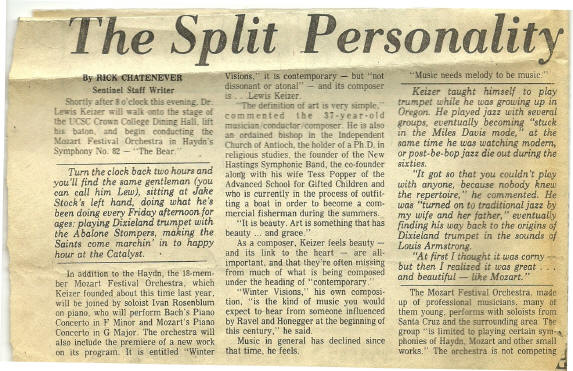
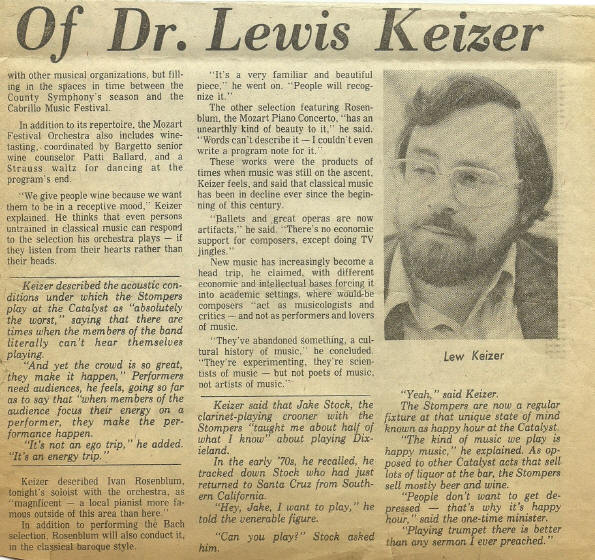
I played weekly with Jake Stock and the Abalone Stompers
for the Friday afternoon Friday Happy Hour plus innumerable gigs at
colleges, universities, private parties, and jazz societies. We never played the
Sacramento Jazz Jubilee or any other jazz festivals because they didn't pay
enough for Jake, but I played them with
other bands. The regulars were Jake on clarinet (upper right), saxes, and
vocals, me on trumpet and later cornet (with white shirt and cornet), Jackson
Stoc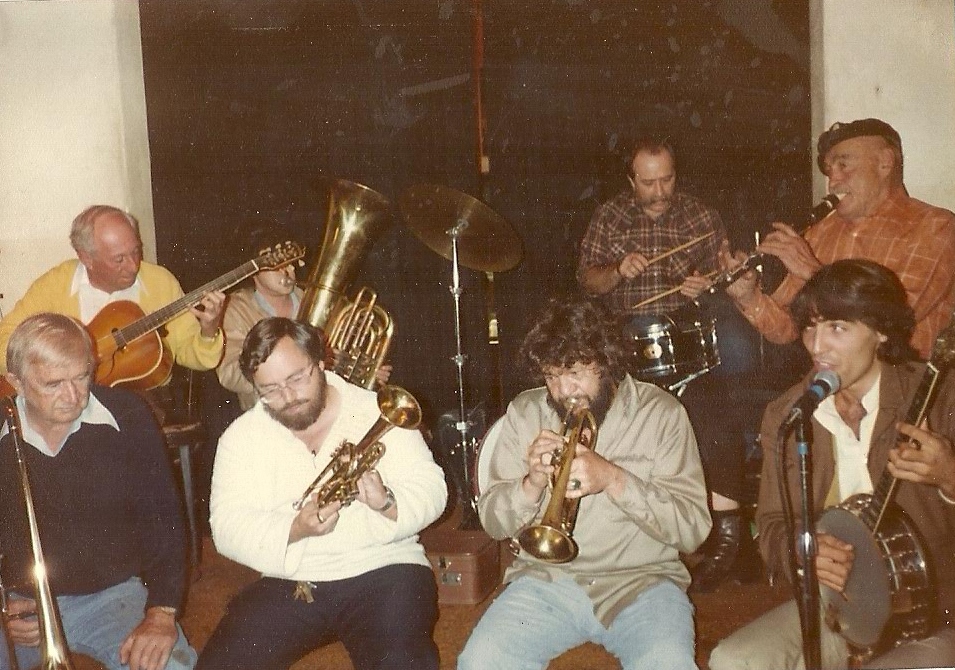 k
or Mo Isaak (bottom left) on Trombone, Alan O'Dae and sometime Danny Marcus on
Tuba (pictured), Bill Newman on Guitar (upper left), and various drummers--don't
remember who the guy in the photo was. Two kids in high school sat in with us regularly--Paul
Mehling (Guitar and vocals pictured)and Danny Marcus (Trombone, Tuba). Both
developed into consummate professionals. Danny honeyfuggled his way into an
audition for solo trombone in the Ray Charles Band and won it, touring for years
with them. Paul has led the excellent Hot
Jazz Club group in San Francisco for decades, performing widely at jazz
festivals. Later in the 1980's the incredible cornetist Jackie Coon moved to
Monterey. I relinquished all my Monterey and farther South gigs
to him but continued to play the Santa Cruz area gigs. However on Friday
afternoon we played with both me and him on cornets at the Catalyst--he played
lead on the head in with me creating a second part, and I played lead on the
head out. He won a Downbeat award for a recording he made. I got my post-grad
jazz harmony ear training from sitting next to him and learning to hear those
sweet passing changes he played so well.
k
or Mo Isaak (bottom left) on Trombone, Alan O'Dae and sometime Danny Marcus on
Tuba (pictured), Bill Newman on Guitar (upper left), and various drummers--don't
remember who the guy in the photo was. Two kids in high school sat in with us regularly--Paul
Mehling (Guitar and vocals pictured)and Danny Marcus (Trombone, Tuba). Both
developed into consummate professionals. Danny honeyfuggled his way into an
audition for solo trombone in the Ray Charles Band and won it, touring for years
with them. Paul has led the excellent Hot
Jazz Club group in San Francisco for decades, performing widely at jazz
festivals. Later in the 1980's the incredible cornetist Jackie Coon moved to
Monterey. I relinquished all my Monterey and farther South gigs
to him but continued to play the Santa Cruz area gigs. However on Friday
afternoon we played with both me and him on cornets at the Catalyst--he played
lead on the head in with me creating a second part, and I played lead on the
head out. He won a Downbeat award for a recording he made. I got my post-grad
jazz harmony ear training from sitting next to him and learning to hear those
sweet passing changes he played so well.
I don't have any recordings of the band, but I do have the tribute to Jake Stock that was read into the Congressional Record by Congressman Sam Farr when Jake died. Here it is:
From the Congressional Record Online
through the Government Printing Office [www.gpo.gov]
TRIBUTE TO JAKE STOCK
______
HON. SAM FARR of California in the house of representatives Friday, May 16, 1997
Mr. FARR of California:
Mr. Speaker, I rise today to pay tribute
to a
man who blessed this world with his music. Jake Stock, who for more
than 50 years was a permanent fixture on the American jazz scene, died
recently at the age of 86. He will be remembered by all those whom he
touched with his sax and song.
Born in Savannah, GA, on July 10, 1910, and having lived an exciting
life since, Mr. Stock moved to Monterey in my congressional district
from Los Angeles in 1938 with his wife, Grace. He quickly started
making music. Offered a job at the Oasis Club in Salinas, Mr. Stock
assembled his prized Abalone Stompers, a jazz ensemble that entertained
thousands for decades to come. The group, composed of anywhere from 5
to 15 players, performed in a variety of festivals and clubs throughout
California and the west coast. In 1958, they opened the Monterey Jazz
Festival and shared the stage with Dizzie Gillespie and Louie
Armstrong.
Throughout his career, Mr. Stock was the recipient of numerous
honors. The inspiration for famed central coast author John Steinbeck's
"Sweet Thursday," he was named Citizen of the Year by Monterey's
Parade of Nations in 1982. Mr. Stock was also honored by Monterey's
Pacheco and Paisano clubs with a dinner called the "Jake Bake.'" Until
recently, he was a featured Sunday played at Big Sur's River Inn.
He is survived by four sons: Jay of Pasadena; Phil of Murphys;
Jackson of Los Angeles and Peter of Portland; three daughters: Judy
Cooper of Lake Havasu City, AZ; Katy Stock of Carmel and Sally Beckett
of Carlsbad; his brother, Morgan Stock of Monterey and five
grandchildren.
1986-Present: After my family and I returned from a long summer of six-day/week gigs for the America's Cup races, playing on Christie's Dock in Newport, Rhode Island, with Jack London's New Orleans dixieland band, I ran in Ed Zimbrick on another gig up in the Delta. We had played together in the Swingmasters for two years in high school, but after graduation he had joined Monte Ballou's Castle Jazz Band and played dixieland, while I had been playing bebop. He went on to work as a professional dixieland musician for Disney and a top-forty band leader in Los Angeles and other places. Now that I had learned the dixieland repertoire (perhaps 2000 tunes and hundreds of traditional arrangements), we decided to form a new dixie band for the festivals, We called it the California Rhythm Kings. We used several of the old Plum Forest players. Ed brought out the old 10th Avenue Jazz Band book that he had copied directly off records by Louis Armstrong, Jellyroll Morton, the Original Dixieland Jazz Band, and other traditional jazz records. 10th Avenue was the name he used for a band he formed back in his Portland State College days. We played many jazz festivals including the Sacramento Jubilee. However, the big earthquake of 1989 effectively ended the band's gigs and we stopped working. Here's a publicity photo. The drummer was Red Malone, who always provided the dixieland band for the Kentucky Derbies and was an accomplished archer and magician. He had appeared on the Johnny Carson show.
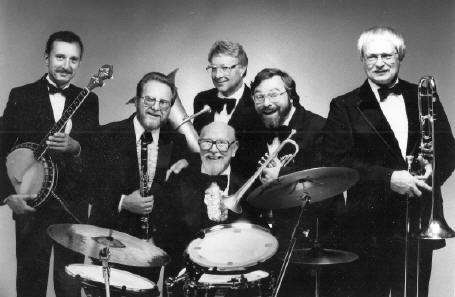
Ed, I, and the California Rhythm Kings playing a Fourth of July parade in the back of a pickup truck. The little fellow on the right is my son Rafael, now a famous cello soloist in Boston.
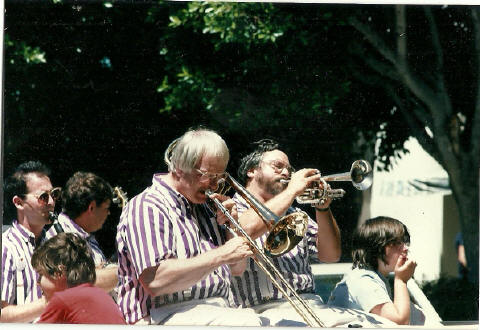
A year after the demise of the California Rhythm Kings, Ed put together a 10th Avenue reunion band to play a few concerts a year up in Portland, Oregon. I hadn't been a member of that band, but after another year he asked me to join because his old cornetist couldn't read music, although he was a great player. That's how I started with the 10th Avenue Band. As of 2012 I have performed with 10th Avenue off and on for about twenty years in Australia, Canada, Europe, and the U.S.
Ed, I, and 10th Avenue playing in Cabo San Lucas in the late 1990's with British bandleader and clarinetist Marty, who joined us for the gig.
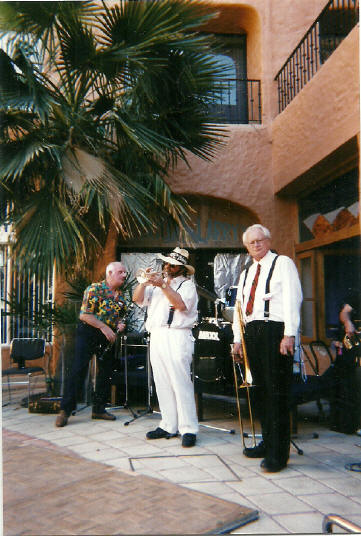
During the '90's I played for a year with the great Stumptown Band from Portland, touring and doing festivals. Here we are below.
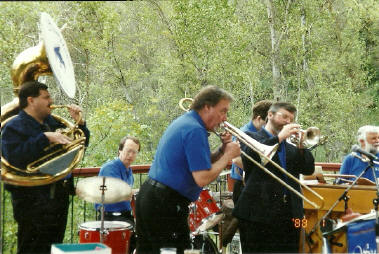
But I also kept my mainstream jazz going, playing lots of gigs with different bands. In the B/W photo, that's Martann Mann (piano) in the white shirt and Frank Leal with the soprano sax,
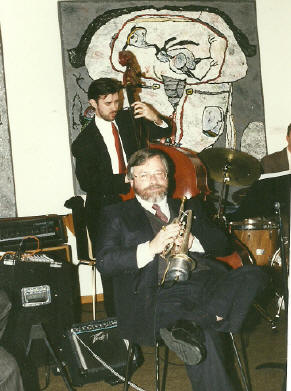
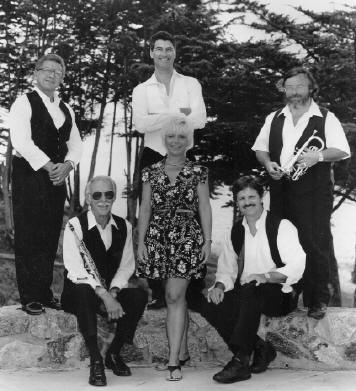
In 1997 I rigged up a guitar sound processor to my horn and started playing my "electric cornet." Also recorded The Electric Cornet of Lewis Keizer with guitarist Mark Hamersley--my first and only recording featuring myself.
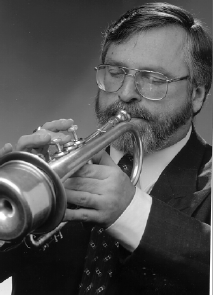

I made the recording in the cold basement of the house Mark's family was leaving. Everything was one take, and I had to give Mark music for the tunes. The purpose was to demonstrate to the Board of Directors of the Edinborough Jazz Festival that I was a great player, even though unknown. They were convinced. They paid me $2500 plus round-trip airfare, room, and board to replace Ruby Braff as their all-star cornetist, perform, and lead a youth clinic. This became the honeymoon for Willa and me, who were married in May, 1998. I got to play with Scott Hamilton and other all-stars.10th Avenue was also at the festival, and Ed was having serious problems with his trumpet player. So he asked me to come in after the festival and perform the rest of his European tour with 10th Avenue, which I did. I continued with 10th Avenue until I got a fulltime job teaching sciences at Westmont High School in 2000.
Next I played mainly with a band at the Elkhorn Yacht Club on Friday nights. It was led by a bari sax player name Jim and we played a lot of West Coast Gerry Mulligan and Kansas City jazz. Jim died after a couple of years and I took over the band. Here we are:

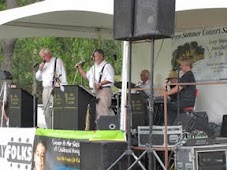 A
few years later Ed dissolved the 10th Avenue Band. I invited him to sit in with
my Yacht Club Band. We decided to join forces and revive the 10th Avenue Band
using my rhythm section and no sax/clarinet player. Ed had been developing
himself as a good singer, taking lessons and turning his repertoire into swing
band vocals. So the 10th Avenue Band was reborn as a swing band that could also
play dixieland. Here we are for the annual summer concert series at Vasona Park
in Los Gatos playing both swing and dixie. If you click the photo to the left,
you'll get a recording of that performance made by a fan.
A
few years later Ed dissolved the 10th Avenue Band. I invited him to sit in with
my Yacht Club Band. We decided to join forces and revive the 10th Avenue Band
using my rhythm section and no sax/clarinet player. Ed had been developing
himself as a good singer, taking lessons and turning his repertoire into swing
band vocals. So the 10th Avenue Band was reborn as a swing band that could also
play dixieland. Here we are for the annual summer concert series at Vasona Park
in Los Gatos playing both swing and dixie. If you click the photo to the left,
you'll get a recording of that performance made by a fan.
Here's the current 10th Avenue Band photo:
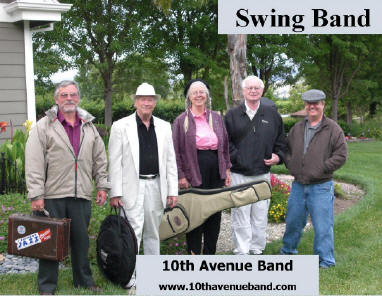
These days 90% of my gigs are with 10th Avenue, but I also do gigs and festivals with Bob Phillips' Sweet Thursday Band consisting of old Abalone Stompers alumni as well as several others.